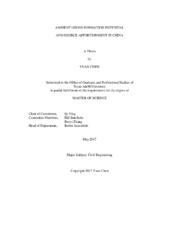| dc.contributor.advisor | Ying, Qi | |
| dc.creator | Chen, Yuan | |
| dc.date.accessioned | 2017-08-21T14:41:32Z | |
| dc.date.available | 2019-05-01T06:08:19Z | |
| dc.date.created | 2017-05 | |
| dc.date.issued | 2017-04-27 | |
| dc.date.submitted | May 2017 | |
| dc.identifier.uri | https://hdl.handle.net/1969.1/161515 | |
| dc.description.abstract | China has been suffering from increasingly higher ozone pollution in the past decade because of rapid economic growth and industrial development. Ozone formation is affected by the nitrogen oxides (NOx) and various volatile organic compounds (VOCs) emitted from both natural and anthropogenic sources. In this study, incremental reactivity (IR) of 66 major VOCs in China was determined using a regional chemical transport model (CTM) and a photochemical box model. A source-oriented CTM was developed to determine the contributions of NOx and VOC sources to ozone formation.
A modified regional Community Multi-scale Air Quality (CMAQ) model (v5.0.1) equipped with a detailed photochemical mechanism SAPRC-11 was used to simulate the ozone concentrations to determine IR under realistic ambient conditions in China during August 2013. The normalized incremental reactivity (NIR) of the VOC, defined as the ratio of the IR of the VOC to the IR of the VOC mixture, was also determined. C4+ aldehydes (NIR50~30) and trimethyl benzenes (NIR50~27) were found to be the most reactive species. The predicted chemical compositions of the VOC mixture from the regional model were used in a photochemical box model to determine the maximum incremental reactivity (MIR) of the VOCs at 34 provincial capital cities in China. The ozone-forming potential (OFP) values of VOCs in Nanjing were calculated using MIR and observed VOC concentrations. Isoprene (0.724), m-xylene (0.652) and toluene (0.555) are the top three species with large OFP values on a per carbon basis.
The source-oriented CTM applied reactive tracers for NOx, VOC precursors and oxidation products for ozone source apportionment analysis. Chinese emissions account for approximately 50% of the hourly ozone concentrations on a monthly average basis, and can be as high as 70% on high ozone hours. Large urban areas such as the Yangtze River Delta and the Pearl River Delta are under VOC-limited conditions. Most of the ozone formation under VOC-limited conditions can be attributed to biogenic and industrial sources, and can be attributed to industrial, power plant and transportation sources under NOx-limited conditions. | en |
| dc.format.mimetype | application/pdf | |
| dc.language.iso | en | |
| dc.subject | Ozone formation potential | en |
| dc.subject | Volatile organic compounds | en |
| dc.subject | Nitrogen oxides | en |
| dc.subject | Incremental reactivity | en |
| dc.subject | Ozone Source Apportionment | en |
| dc.title | Ambient Ozone Formation Potential and Source Apportionment in China | en |
| dc.type | Thesis | en |
| thesis.degree.department | Civil Engineering | en |
| thesis.degree.discipline | Civil Engineering | en |
| thesis.degree.grantor | Texas A & M University | en |
| thesis.degree.name | Master of Science | en |
| thesis.degree.level | Masters | en |
| dc.contributor.committeeMember | Batchelor, Bill | |
| dc.contributor.committeeMember | Zhang, Renyi | |
| dc.type.material | text | en |
| dc.date.updated | 2017-08-21T14:41:32Z | |
| local.embargo.terms | 2019-05-01 | |
| local.etdauthor.orcid | 0000-0003-4869-8471 | |


